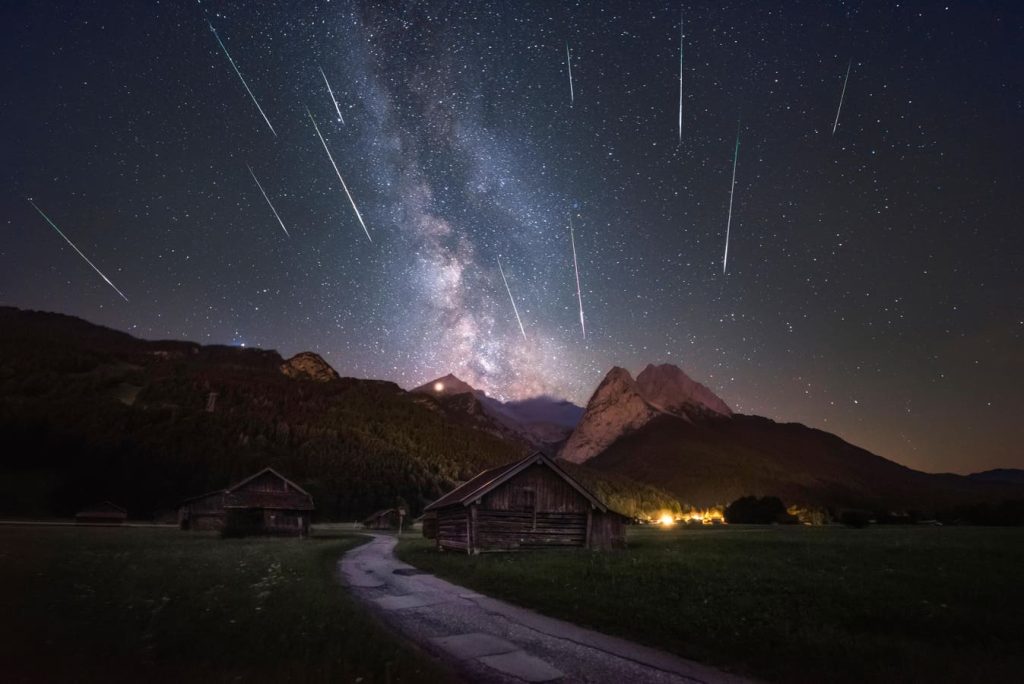The “Great North American Eclipse” is history, but if it’s left you wondering when the next eclipse is, console yourself with this fact—a major meteor shower is coming, one of just 21 stunning sights to see in the night sky for the rest of 2024.
From Uranus hanging out next to Jupiter and Venus to a “Blue Moon” and bits of Halley’s comet shining brightly in the night sky, here’s what you need to know about stargazing in 2024.
1. April 19, 20, 21: Jupiter And Uranus In Conjunction
Look at the western skies just after sunset and see the bright planet Jupiter and the dim planet Uranus, which are just half a degree from each other. Just below will be a comet.
2. April 21: Comet Pons-Brooks Brightest
Comet Pons-Brooks is a short-period comet that loops around the sun every 71 years, which should be visible in binoculars during March and April. It will be at peak brightness on April 21. You will likely need binoculars.
3. April 23: A Full ‘Pink Moon’ Rise
Look east at moonrise to see April’s full moon rising as a deep orange orb.
4. May 5-6: Eta Aquariids Meteor Shower
The debris of Halley’s comet, the Eta Aquariids, is one of just three meteor showers 2024 that will peak in dark, moonless skies.
5. May 23: A Full ‘Flower Moon’ Rising
The “Flower Moon” will appear close to the red supergiant star Antares in the constellation Scorpius.
6. May 29-July 12: ‘Manhattanhenge’
Between May 29 and July 12, the sun will set between skyscrapers as seen from Manhattan, New York City. On May 29-30 and July 11-12, the sunset will “kiss the grid.”
7. June: International Space Station
The ISS will be exceptionally bright from the northern hemisphere after sunset in June, rising in the west and setting in the east.
8. Late June To Mid-July: Noctilucent Clouds
The peak months for noctilucent or “night-shining” clouds are high in Earth’s atmosphere. Look to the north and northeastern sky late at night.
9. June 4, 5: Jupiter And Mercury In Conjunction
This is the best planetary conjunction of the year! Look east before sunrise on June 4 to see the giant planet Jupiter half a degree from the “Swift Planet.” Use binoculars. The crescent moon joins on June 5.
10. June 21: A Full ‘Strawberry Solstice Moon’ Rising
The first full moon of summer in the northern hemisphere will occur the day after June 20’s solstice. It will be the lowest-hanging full moon of the year.
11. July 15: Mars And Uranus In Conjunction
If you look east before sunrise, you’ll see Mars shining brightly above Jupiter. Uranus will be to the immediate upper left of Mars.
12. July 20-21: A Full ‘Buck Moon’ Rising
A particularly low and late-rising full moon, July’s is also called the “Thunder Moon.”
13. July: Scorpius And Sagittarius
Look south for the tail of the famous Scorpius constellation, featuring the red supergiant star Antares and the M4 globular cluster of 1,000+ stars. Nearby is Sagittarius over the galactic central point.
14. August 12-13: Perseid Meteor Shower
The year’s biggest and best display of meteors will occur overnight on August 12/13. Go camping—it’s the best way to see it.
15. August 14: Mars And Jupiter In Conjunction
Look east before sunrise to see Mars and Jupiter a third of a degree apart high in the sky.
16. August 18: A Full ‘Super Sturgeon Blue Moon’ And Saturn
A seasonal “blue moon”—the third of four full moons in one astronomical season—will shine close to Saturn.
17. September: Summer Triangle
Overhead after dark in September, the Summer Triangle comprises Deneb in Cygnus, bright Vega in Lyra and Altair in Aquila. The Milky Way streams through it.
18. September 8: Saturn’s Rings At Their Best
Tonight, Earth will be between the sun and the sixth planet, making it look its best of the year. Find any small telescope for an unforgettable sight.
19. September: Corona Borealis
High in the sky, the “Northern Crown” is a semi-circle curve of seven stars between the constellations of Boötes and Hercules.
20. September 17: Full ‘Super Harvest Moon Eclipse’
Did you think there were no more eclipses in 2024? The “Harvest Moon”—the closest to the equinox—will rise in the east and, later tonight, move through the Earth’s outer shadow in space. A slight partial lunar eclipse will result for the night side of Earth, including North and South America, Europe, Africa, and the Middle East. It’s also a “supermoon.”
21. September: Northern Lights At Equinox
The arrival of the fall equinox on September 22 will end summer, but it comes with an increased chance of northern lights. That’s because the planet is side-on to the solar wind, meaning it’s more likely to interact with the charged particles to produce dazzling displays in the Arctic Circle and, occasionally, in the northern U.S. states.
Wishing you clear skies and wide eyes.
The times and dates given apply to mid-northern latitudes. For the most accurate location-specific information, consult online planetariums like Stellarium and The Sky Live. Check planet-rise/planet-set, sunrise/sunset, and moonrise/moonset times to see where you are.
Read the full article here






